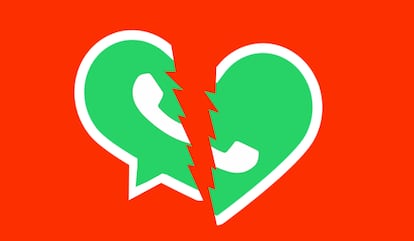Emojis, double blue checks, and the ominous ‘typing...’: How WhatsApp has changed our relationships
We live in the era of duplication: we have a face-to-face identity and another in the digital world. And because it is new, our online persona needs some basic rules when emotions come into play

They call it a “messaging system,” but in reality WhatsApp adds an extra dimension to our relationships. It is a channel where communication is sometimes more fluid and affectionate than in person and, at the same time, it is an emotional minefield. Imagine the scene: you have just met someone charming, but on WhatsApp they are an idiot. What do you do when one of the parties is really bad at communicating in writing, and how can you tell the difference between getting involved with someone who is genuinely confrontational or just someone who is clumsy when communicating via text?
Inma Brea, expert coach in human behavior and corporate humanization, warns that instant messaging is, as its name indicates, “immediate gratification. The cell phone goes everywhere with us, which means that we can receive stimuli or gratification constantly.” That has made it an essential element in romantic relationships in an era of digital intimacy. The problem, as at the dawn of every era, is that the codes are not yet the same for everyone. What may be the norm for one party may be excessive communication for the other. What one side believes is a simple and assertive reply (“okay”), may be received by the other as cold and distant. What may be attentive and loving for one may be excessive and overwhelming for another. Today, the use (or absence) of emojis can be interpreted as a declaration of war.
Psychologist Júlia Pascual emphasizes the importance of establishing communication rules and setting boundaries from the beginning of a relationship. She emphasizes “the need to be polite” above all. “If you read someone else’s message, no matter how busy you are,” she recommends, “you have to let them know that you cannot respond at that time and that you will do so later, because you have to be polite and respectful.” The expert remarks that, contrary to what one may think, “the rules for people having a fling,” or for people who are just getting to know each other, “have to be more rigid than those for a couple. There has to be much more regulation.” Why? By not knowing the other as well, by not identifying their silences and decoding their reactions, as we know how to do with a long-term partner, it is easier to let our imagination run riot and make ourselves anxious. The psychologist gives an example: “If they don’t respond, you should not automatically think that they’re doing it to assert their power.”
Can two people with completely opposite ways of communicating online have a successful relationship? The long answer is yes: “It is necessary to understand our partner’s love language,” says Inma Brea. “A relationship can survive these differences if both parties understand and respect how the other expresses their love, communicates their needs, and makes commitments.” In other words: it is not about demanding that the other respond instantly, but rather about knowing that sometimes they do not, and understanding that it is part of their personality. This will prevent you from staring into the abyss of the double blue checks (which on many networks indicate that the other person has received and also read the message), which often tests a lover’s nerves.
“Taking a while to respond to a message can be a strategy to assert control or power over the other,” warns psychologist Judith March. “In the tug-of-war technique, or taking time to respond to the other, intermittent reinforcement is used: we show a lot of interest in the person at certain times and at other times, we do not show interest or we are absent. This strategy, in the long run, creates addiction.”
Antonio H. is a 39-year-old data analyst and has been with his partner for seven years. His partner answers such a low percentage of Antonio’s messages that often when he gets a response, he has forgotten what the question was. ”If you are not mentally prepared, this really affects you because you think you are the problem. As you get to know the other person over time, you don’t take it as such a personal thing. I have lost my fear of that lack of response, and when he doesn’t answer me, I insist again and again until he responds. I don’t dwell on it, like I did at the beginning. Then, obviously, if we’ve had a fight, or he is angry, I know that it has something to do with his lack of response. In short: if you are not at ease when you start a relationship with someone like that, it affects you a lot. You have to be strong to deal with it and to try to transform it,” he explains.
At the other end of the scale are those who write constantly and to the point of overwhelming the other. When such conversational asymmetry is noticeable, it is essential to say something about it. “The rhythm in a WhatsApp conversation is established between the two people, in the same way as when we are talking. The ideal would be for there to be symmetry and to initiate possible conversation topics that help us get to know the other person better. Talking a lot shows interest in the other person and it is not bad if they also interact in a similar way. When there is a certain asymmetry in communication, or the other person writes too often, it is important that we communicate this to them, because in the long run it could become overwhelming and cause us to lose interest,” says Judith March. Inma Brea points out that these warnings and requests can, in fact, be the key to a healthy relationship. “Relationships that work do so because they have gone through uncomfortable times of adjustment. If everything flows too easily, it is likely that one of the two is giving too much.”
The right emoji
Text is part of digital communication, but we have not yet talked about another significant part. Emojis are the digital way of expressing hundreds of feelings with pictograms, ideograms, and smileys. It is important to note that in reality, emojis have no established meaning, grammar, or syntax. However, we give them a semantic meaning that for some has turned into a kind of secret and intimate language. In the fifth season of the Netflix reality show Love Is Blind, one of the participants told his partner that if she felt uncomfortable talking to her ex, she should send him the gasoline pump emoji via WhatsApp. “Who actually uses it? That’s why I suggested she used that one in particular: because then it wouldn’t raise suspicions when sending it, and only we know its meaning,” he later explained.
“Emojis are symbols that allow us to stop using verbal language to communicate and avoid emotional burdens. For example, sending a heart instead of ‘I love you’ is a way to not get so involved or to get out of trouble,” explains March. But she also warns that “the excessive use of emojis can prevent us from establishing deeper and more meaningful links, since they often only manage to convey a superficial approach to emotions and feelings.”
“Written communication lacks body language and emojis try to replace that body language, which is why they have been integrated so well into written communication,” adds March. “However, excessive use of emojis can prevent us from establishing deeper and stronger connections.” Sending a heart or an angry face is all well and good, but the path to any solid bond is to openly communicate that you feel loved or angry.
Júlia Pascual recalls that Paul Watzlawick (considered one of the fathers of the Theory of Human Communication and Constructivism) points out that verbal communication cannot be conceived without the context in which it occurs. “Here lies the difficulty: at the moment we are communicating in a chat, people are split between two contexts: their digital presence and real life. Digital communication is not the same as communicating in person. It may happen that in real life someone communicates lovingly and affectionately, but when connecting on a digital level, they resort to monosyllables. It is recommended that in the face-to-face context you put your cell phone down and focus on your reality, and when you connect digitally, do everything possible to make time for it so that you can the conversation your attention and avoid being disrespectful or irresponsible,” she says. In short, an “I’m busy, talk to you later” message can avoid a lot of misunderstanding.
Sign up for our weekly newsletter to get more English-language news coverage from EL PAÍS USA Edition
Tu suscripción se está usando en otro dispositivo
¿Quieres añadir otro usuario a tu suscripción?
Si continúas leyendo en este dispositivo, no se podrá leer en el otro.
FlechaTu suscripción se está usando en otro dispositivo y solo puedes acceder a EL PAÍS desde un dispositivo a la vez.
Si quieres compartir tu cuenta, cambia tu suscripción a la modalidad Premium, así podrás añadir otro usuario. Cada uno accederá con su propia cuenta de email, lo que os permitirá personalizar vuestra experiencia en EL PAÍS.
¿Tienes una suscripción de empresa? Accede aquí para contratar más cuentas.
En el caso de no saber quién está usando tu cuenta, te recomendamos cambiar tu contraseña aquí.
Si decides continuar compartiendo tu cuenta, este mensaje se mostrará en tu dispositivo y en el de la otra persona que está usando tu cuenta de forma indefinida, afectando a tu experiencia de lectura. Puedes consultar aquí los términos y condiciones de la suscripción digital.
More information
Archived In
Últimas noticias
Most viewed
- Sinaloa Cartel war is taking its toll on Los Chapitos
- Oona Chaplin: ‘I told James Cameron that I was living in a treehouse and starting a permaculture project with a friend’
- Reinhard Genzel, Nobel laureate in physics: ‘One-minute videos will never give you the truth’
- Why the price of coffee has skyrocketed: from Brazilian plantations to specialty coffee houses
- Silver prices are going crazy: This is what’s fueling the rally











































